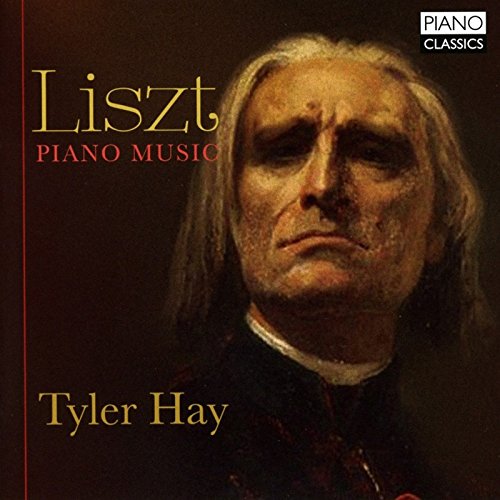LISZT Piano Music (Tyler Hay)
View record and artist detailsRecord and Artist Details
Composer or Director: Franz Liszt
Genre:
Instrumental
Label: Piano Classics
Magazine Review Date: AW18
Media Format: CD or Download
Media Runtime: 73
Mastering:
DDD
Catalogue Number: PCL10138

Tracks:
| Composition | Artist Credit |
|---|---|
| Fantasia and Fugue on the theme B-A-C-H |
Franz Liszt, Composer
Franz Liszt, Composer Tyler Hay, Piano |
| (4) Valses oubliées |
Franz Liszt, Composer
Franz Liszt, Composer Tyler Hay, Piano |
| Années de pèlerinage année 3, Movement: Les jeux d'eau à la Villa d'Este |
Franz Liszt, Composer
Franz Liszt, Composer Tyler Hay, Piano |
| Mephisto Waltz No. 1, 'Der Tanz in der Dorfschenke |
Franz Liszt, Composer
Franz Liszt, Composer Tyler Hay, Piano |
| Ballade No. 1 |
Franz Liszt, Composer
Franz Liszt, Composer Tyler Hay, Piano |
| Variations on 'Weinen, Klagen, Sorgen, Zagen' (Bach) |
Franz Liszt, Composer
Franz Liszt, Composer Tyler Hay, Piano |
| Schwanengesang (Schubert), Movement: No. 5, Abschied |
Franz Liszt, Composer
Franz Liszt, Composer Tyler Hay, Piano |
Author: Patrick Rucker
The monumental rhetorical stance of the ‘B A C H’ Fantasy and Fugue poses significant challenges for the pianist, lest its grandeur devolve into 12 minutes of undifferentiated banging. Fortunately, Hay successfully clears this hurdle with his fluent technique and basically healthy sound. But other musical concerns persist. At the beginning Liszt sets out the motif – B flat, A, C, B natural – in left-hand octave crochets seven times before arriving at a series of three quavers, marked ritenuto (held back). Hay starts to accelerate from the beginning, creating an increasing spiral checked only by the quaver chords. This sort of distortion of the principal material’s first presentation in any music leaves the interpreter at a distinct disadvantage since, as the musical narration progresses, the ‘topic’ of discourse remains ambiguous. Throughout, Hay seems uncertain which textures to foreground. At 6'36", to cite one example, the interlocking chromatic octaves are suddenly thrust to the fore. They are, without doubt, very fine chromatic octaves but here they obscure the shifting harmonies they are meant to embellish. Most problematic is Hay’s tendency to render sequential passages identically, whether they are meant to intensify or diminish. Overall we are left with the impression of an agglomeration of striking and often beautiful details that nevertheless fall short of coming to grips with the underlying expressive crux of the music.
Unlike ‘B A C H’, which was originally conceived for organ and later transcribed for piano, the 1862 ‘Weinen, Klagen’ Variations were composed as a piano piece from which the better-known organ version was derived. Hay’s metronomic approach to Bach’s basso continuo figure upon which Liszt builds his passacaglia-like variations effectively deprives this moving work of its pathos.
The four Valses oubliées, though composed separately, form a delicate microcosm of Liszt’s last half-decade. Hay acknowledges their innovative harmonies but as dances they are curiously motoric and bereft of charm and grace. The decision to sandwich in an oddly pixilated ‘Les jeux d’eau à la Villa d’Este’ between the first and second Valses oubliées was a particularly unfortunate programming choice. The First Mephisto Waltz fares better than the forgotten ones because its greater textural variety serves as a distraction from the underlying waltz. Yet here, as well as in the strangely bleached-out First Ballade, one wishes for greater variety of touch, more pliant tempos and, above all, more vivid colours.
Discover the world's largest classical music catalogue with Presto Music.

Gramophone Digital Club
- Digital Edition
- Digital Archive
- Reviews Database
- Full website access
From £8.75 / month
Subscribe
Gramophone Full Club
- Print Edition
- Digital Edition
- Digital Archive
- Reviews Database
- Full website access
From £11.00 / month
Subscribe
If you are a library, university or other organisation that would be interested in an institutional subscription to Gramophone please click here for further information.




